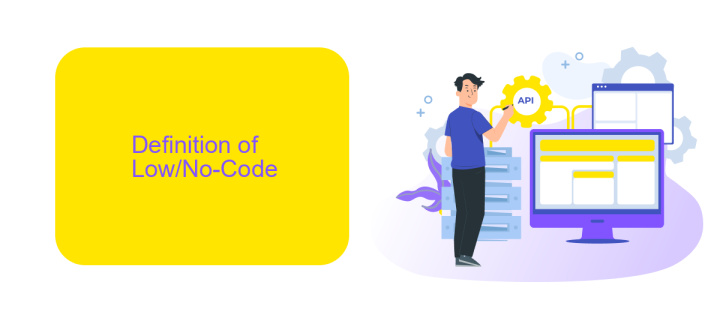What is Low/No-Code
Low/No-Code platforms are revolutionizing the way software is developed by enabling users to create applications with minimal or no programming knowledge. These tools provide intuitive, visual interfaces that streamline the development process, making it accessible to non-developers and accelerating project timelines. In this article, we will explore the key features, benefits, and potential limitations of Low/No-Code solutions.
Introduction
In today's fast-paced digital world, the demand for rapid application development has never been higher. Low/No-Code platforms are emerging as a revolutionary solution, enabling even non-technical users to create powerful applications without writing a single line of code. These platforms democratize software development, making it accessible to a broader audience and accelerating the innovation process.
- Low-Code: Offers a visual development environment with drag-and-drop features, requiring minimal coding.
- No-Code: Provides a fully visual interface with pre-built templates, eliminating the need for any coding skills.
- Integration Tools: Services like ApiX-Drive facilitate seamless integrations between different applications, enhancing functionality without complex coding.
By leveraging Low/No-Code platforms, businesses can significantly reduce development time and costs. Tools like ApiX-Drive further streamline the process by enabling easy integration with various services, allowing users to create comprehensive solutions tailored to their specific needs. This paradigm shift is empowering organizations to innovate faster and stay competitive in an ever-evolving market.
Definition of Low/No-Code

Low-code and no-code platforms are revolutionary tools designed to simplify the application development process. Low-code platforms provide a visual interface with pre-built modules and drag-and-drop functionality, enabling users with minimal coding knowledge to create complex applications. No-code platforms take this a step further by allowing users to build applications without any coding at all, relying entirely on visual development environments and pre-configured templates.
These platforms are designed to democratize software development, making it accessible to a broader audience, including business analysts and non-technical staff. One of the key features of low-code and no-code platforms is their ability to integrate with various services and applications seamlessly. For instance, ApiX-Drive is a service that facilitates easy integration between different software systems, allowing users to automate workflows without writing a single line of code. This enhances productivity and reduces the time and cost associated with traditional development methods.
Benefits of Low/No-Code

Low/No-Code platforms offer numerous advantages for businesses and developers alike. They enable rapid application development, allowing users to create and deploy applications much faster compared to traditional coding methods. This speed is crucial in today's fast-paced business environment, where time-to-market can be a significant competitive advantage.
- Cost Efficiency: Reduces the need for extensive coding expertise, lowering development costs.
- Accessibility: Empowers non-technical users to create applications, democratizing the development process.
- Flexibility: Allows for easy modifications and updates, ensuring that applications can evolve with business needs.
- Integration: Tools like ApiX-Drive facilitate seamless integration with various services, enhancing functionality.
- Scalability: Supports the growth of applications as business demands increase.
By leveraging Low/No-Code platforms, organizations can streamline their development processes and focus on innovation. These platforms not only reduce the dependency on specialized IT skills but also foster a more collaborative environment where business and IT teams can work together efficiently. This holistic approach ultimately leads to more agile and responsive business operations.
Applications of Low/No-Code

Low/No-Code platforms are revolutionizing the way businesses develop and deploy applications. These tools enable users with little to no programming experience to create functional applications quickly and efficiently. This democratization of app development is fostering innovation across various industries.
One of the primary applications of Low/No-Code platforms is in the automation of business processes. By using these tools, organizations can streamline workflows, reduce manual tasks, and enhance productivity. Additionally, these platforms are ideal for rapid prototyping, allowing businesses to test and iterate on ideas without significant investment in development resources.
- Automating routine business processes
- Creating internal tools and dashboards
- Developing customer-facing applications
- Setting up integrations with other software and services
For instance, services like ApiX-Drive facilitate seamless integrations between various applications, enabling businesses to synchronize data and automate workflows effortlessly. By leveraging Low/No-Code platforms, companies can respond more quickly to market changes and customer needs, ultimately driving growth and innovation.
- Automate the work of an online store or landing
- Empower through integration
- Don't spend money on programmers and integrators
- Save time by automating routine tasks
Conclusion
In conclusion, Low/No-Code platforms are revolutionizing the way businesses approach software development by democratizing access to technology. These platforms enable users with little to no programming knowledge to create, customize, and deploy applications swiftly, thus accelerating innovation and reducing costs. As companies strive to keep pace with digital transformation, Low/No-Code solutions offer a practical and efficient pathway to staying competitive in an ever-evolving market.
Moreover, the integration capabilities of Low/No-Code platforms, such as those provided by ApiX-Drive, further enhance their utility. ApiX-Drive allows users to seamlessly connect various applications and automate workflows without the need for extensive coding skills. This ease of integration ensures that businesses can optimize their operations, improve productivity, and focus on strategic growth. As Low/No-Code technology continues to evolve, its impact on the business landscape will undoubtedly expand, making it an indispensable tool for modern enterprises.
FAQ
What is Low/No-Code?
Who can benefit from Low/No-Code platforms?
How do Low/No-Code platforms impact traditional software development?
Can Low/No-Code platforms be used for complex applications?
How can Low/No-Code platforms help with automation and integration?
Do you want to achieve your goals in business, career and life faster and better? Do it with ApiX-Drive – a tool that will remove a significant part of the routine from workflows and free up additional time to achieve your goals. Test the capabilities of Apix-Drive for free – see for yourself the effectiveness of the tool.


